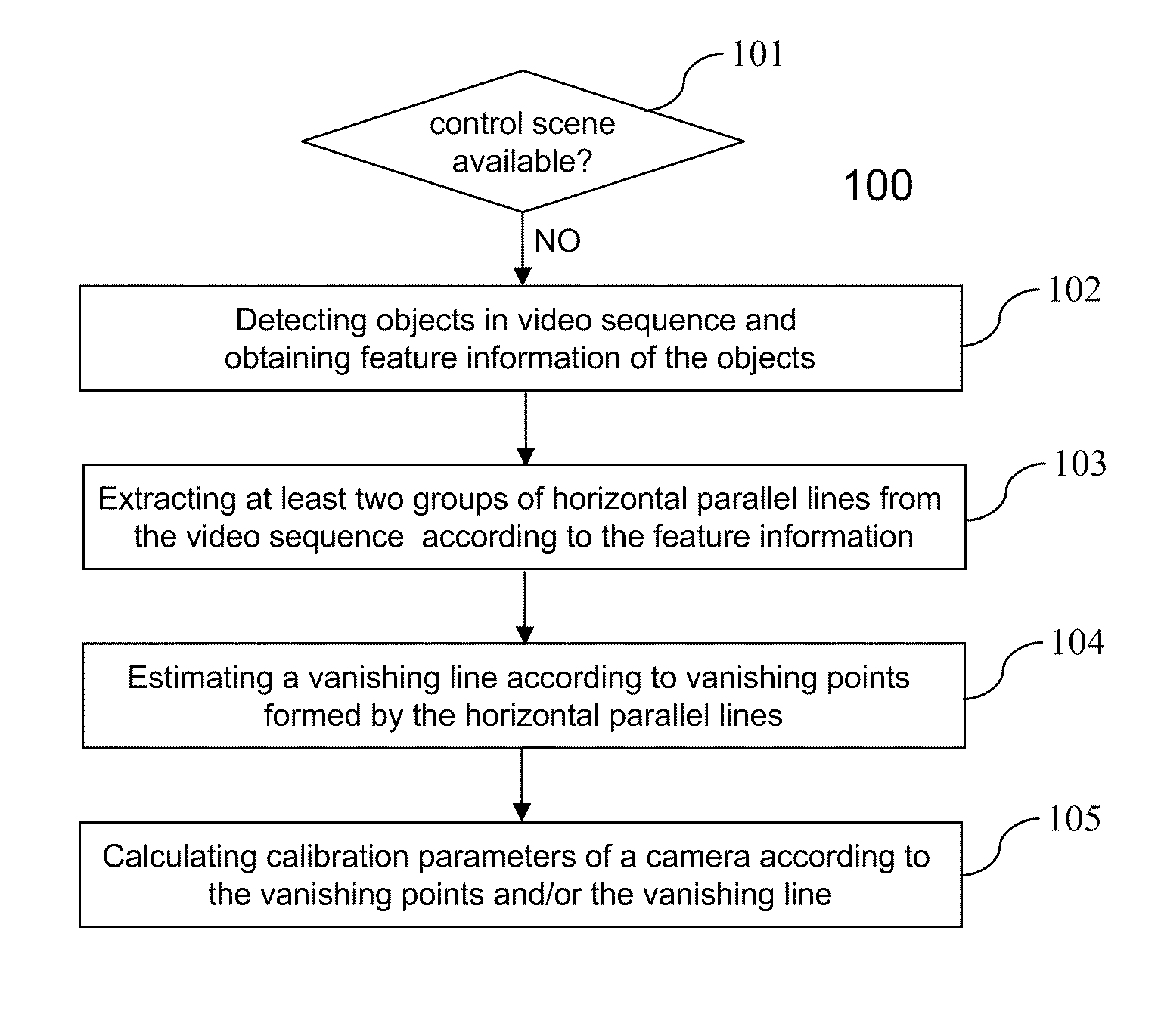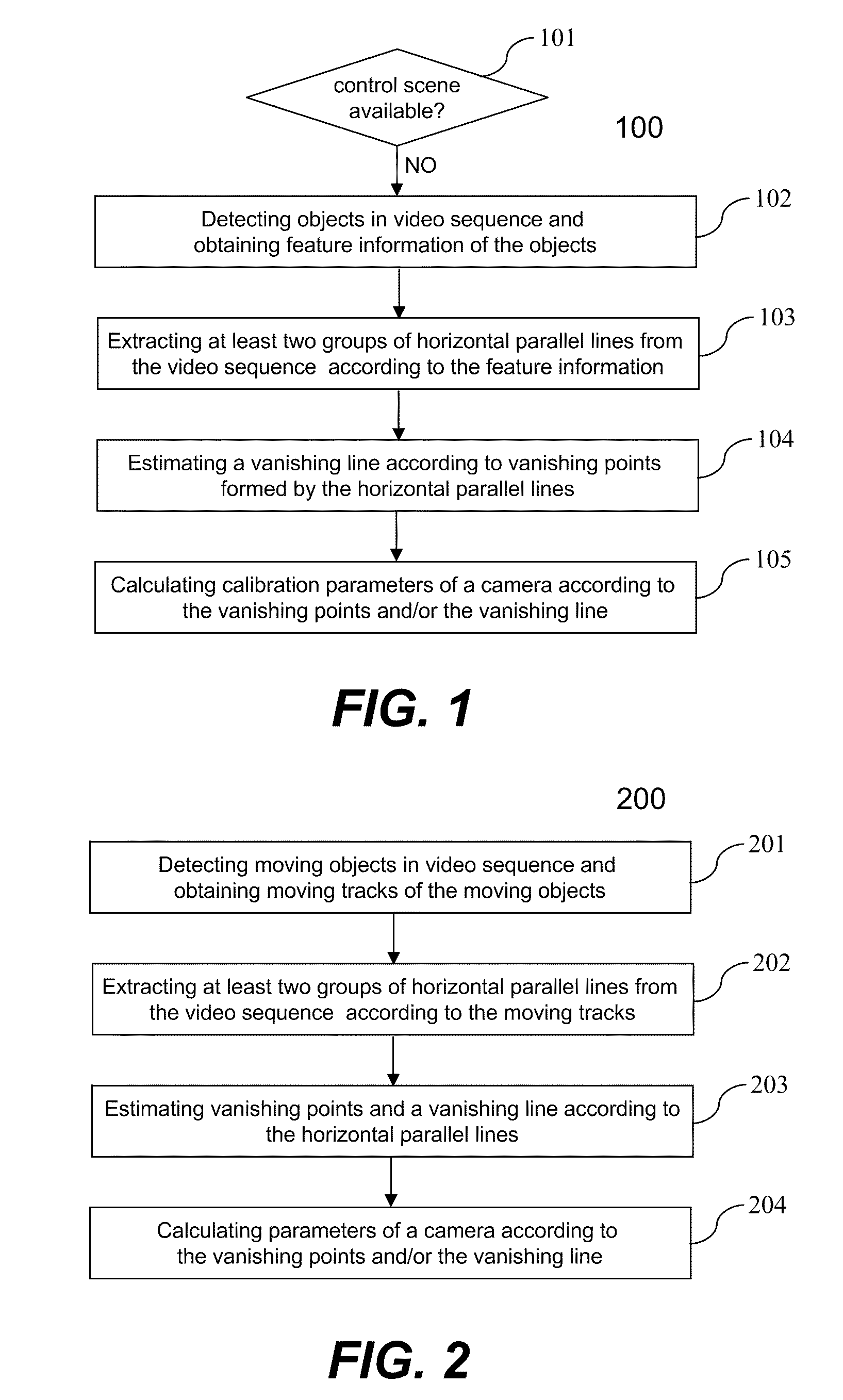Method and device for camera calibration
a camera and calibration technology, applied in the field of camera calibration, can solve the problems of not always available, difficult manual arrangement of implementing the 3d control scene method, and current camera self-calibration technology is not very reliable,
- Summary
- Abstract
- Description
- Claims
- Application Information
AI Technical Summary
Benefits of technology
Problems solved by technology
Method used
Image
Examples
first embodiment
[0031]FIG. 1 is a flowchart or process 100 of showing camera calibration according to the present invention. The process 100 may be implemented in a processor in a camera. At 101, the process 100 checks whether a prearranged control scene is available for camera calibration. If no, the process 100 is taken to the operation at 102. If yes, a conventional camera calibration method based on the control scene is used to estimate the calibration parameters of the camera. In one embodiment, a control scene is an actual 3D control scene, and a classic numerical analysis algorithm may be provided to calculate the calibrate parameters. In another embodiment, a 2D control scene is prearranged in a plane for camera calibration when the objects of interest are located on the ground such as in the video surveillance application It requires only four control points in the 2D control scene to calculate the homography matrix between the ground plane in the image and the ground plane in the real spa...
second embodiment
[0038]FIG. 2 is a flowchart or process 200 for camera calibration according to the present invention. The process 200 may be implemented in a processor in a camera. At 201, moving objects are detected from video sequence captured by the camera and moving tracks of the moving objects are obtained. In one embodiment, the operation for detecting moving objects from video sequence comprises: establishing a background image of the video sequence which contains stationary objects of a scene; subtracting the background image from a current image which may contain moving objects; binarizing the difference image between the background image and the current image; analyzing connected components of the binarization image to obtain position and shape information of each moving object.
[0039]The moving tracks of the moving objects can be obtained by tracking the moving objects in the video sequence. Any conventional methods for tracking the moving objects can be used to obtain the moving tracks o...
fourth embodiment
[0051]FIG. 5 is a flowchart or process 500 showing camera calibration according to the present invention. The process 500 may be implemented in a processor in a camera. At 501, objects with same height are detected from a video sequence. The positions, tops and bottoms of the moving objects are obtained. The objects with same height may be moving objects or stationary. E.g., the moving objects may be vehicles or walking human beings, and the stationary objects may be telegraph poles or footsteps.
[0052]At 502, at least two groups of perspective horizontal parallel lines are extracted from the video sequence according to the positions, the tops and the bottoms of the objects. A straight line connecting the tops and a straight line connecting the bottoms of two objects at different positions forms a group of perspective horizontal parallel lines because the two objects are at height. Thus, a plurality of perspective horizontal parallel lines can be obtained according to a plurality of ...
PUM
 Login to View More
Login to View More Abstract
Description
Claims
Application Information
 Login to View More
Login to View More - R&D
- Intellectual Property
- Life Sciences
- Materials
- Tech Scout
- Unparalleled Data Quality
- Higher Quality Content
- 60% Fewer Hallucinations
Browse by: Latest US Patents, China's latest patents, Technical Efficacy Thesaurus, Application Domain, Technology Topic, Popular Technical Reports.
© 2025 PatSnap. All rights reserved.Legal|Privacy policy|Modern Slavery Act Transparency Statement|Sitemap|About US| Contact US: help@patsnap.com



